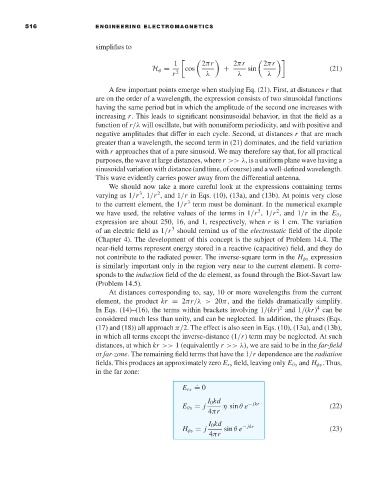Page 534 - Engineering Electromagnetics, 8th Edition
P. 534
516 ENGINEERING ELECTROMAGNETICS
simplifies to
1 2πr 2πr 2πr
H φ = cos + sin (21)
r 2 λ λ λ
Afew important points emerge when studying Eq. (21). First, at distances r that
are on the order of a wavelength, the expression consists of two sinusoidal functions
having the same period but in which the amplitude of the second one increases with
increasing r. This leads to significant nonsinusoidal behavior, in that the field as a
function of r/λ will oscillate, but with nonuniform periodicity, and with positive and
negative amplitudes that differ in each cycle. Second, at distances r that are much
greater than a wavelength, the second term in (21) dominates, and the field variation
with r approaches that of a pure sinusoid. We may therefore say that, for all practical
purposes, the wave at large distances, wherer >> λ,isa uniform plane wave having a
sinusoidal variation with distance (and time, of course) and a well-defined wavelength.
This wave evidently carries power away from the differential antenna.
We should now take a more careful look at the expressions containing terms
3
2
varying as 1/r ,1/r , and 1/r in Eqs. (10), (13a), and (13b). At points very close
3
to the current element, the 1/r term must be dominant. In the numerical example
3 2
we have used, the relative values of the terms in 1/r ,1/r , and 1/r in the E θs
expression are about 250, 16, and 1, respectively, when r is 1 cm. The variation
3
of an electric field as 1/r should remind us of the electrostatic field of the dipole
(Chapter 4). The development of this concept is the subject of Problem 14.4. The
near-field terms represent energy stored in a reactive (capacitive) field, and they do
not contribute to the radiated power. The inverse-square term in the H φs expression
is similarly important only in the region very near to the current element. It corre-
sponds to the induction field of the dc element, as found through the Biot-Savart law
(Problem 14.5).
At distances corresponding to, say, 10 or more wavelengths from the current
element, the product kr = 2πr/λ > 20π, and the fields dramatically simplify.
2
4
In Eqs. (14)–(16), the terms within brackets involving 1/(kr) and 1/(kr) can be
considered much less than unity, and can be neglected. In addition, the phases (Eqs.
(17) and (18)) all approach π/2. The effect is also seen in Eqs. (10), (13a), and (13b),
in which all terms except the inverse-distance (1/r) term may be neglected. At such
distances, at which kr >> 1 (equivalently r >> λ), we are said to be in the far-field
or far-zone. The remaining field terms that have the 1/r dependence are the radiation
fields. This produces an approximately zero E rs field, leaving only E θs and H φs . Thus,
in the far zone:
.
E rs = 0
I 0 kd
E θs = j η sin θ e − jkr (22)
4πr
I 0 kd
H φs = j sin θ e − jkr (23)
4πr

